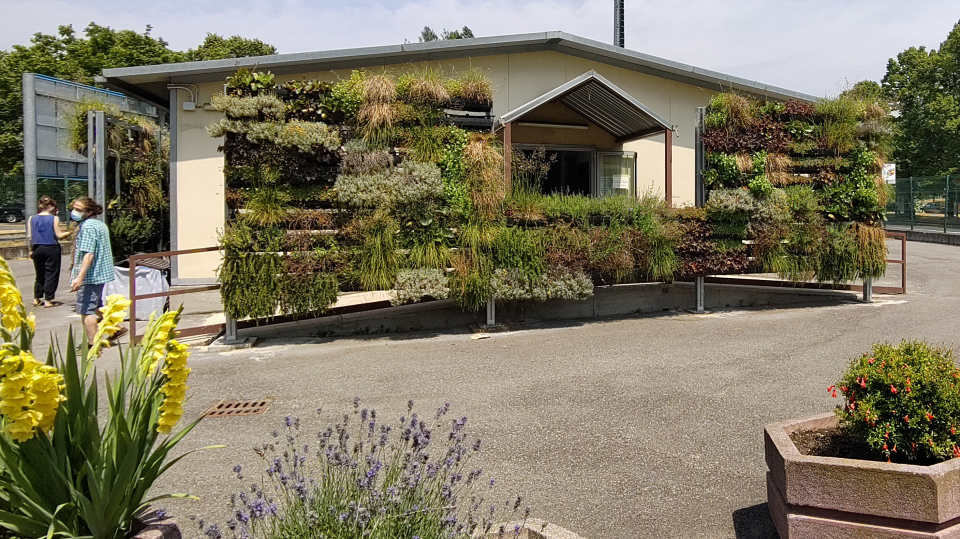
South Mirafiori district is a part of the city is famous because here FIAT was born and all the area was design and developed to host its workers. Today the area suffer from post-industrial heritage such as high seniority of population, great unemployment, loss of relational fabric.
Schools in South Mirafiori district are suffering from decreasing number of students. More well-off families tend to enroll their children in schools nearer to the city center. As a consequence, a high percentage of children in Mirafiori schools come from economically and socially disadvantaged families.
The NbS consists of two implemented green walls in the Mirafiori Sud district:
1. Indoor green wall (20 m²) in the atrium of the elementary school IC Cairoli lit by large roof windows.
2. Outdoor green wall (80 m²) of a homeless shelter build as self-supporting structure, owned by the City of Turin and managed by a social cooperative.
- The experimental features of this NbS are intended as replicable examples in enhancing urban environments and improving living conditions of inhabitants.
- Working with schools to spread the knowledge about NbS to users of the buildings and raising awareness about the importance of plants in everyday life.
- Promoting the collaboration with school teachers and staff of the homeless shelter to schedule activities that supported learning “science” disciplines, as well as Italian language skills, civic education and social studies.
- Consulting a nursery to achieve aesthetic and botanically valuable green walls in line with botanical characteristics of small seedlings that attract pollinating insects (bees, bumblebees, butterflies) for the outdoor wall
- To encourage homeless and staff participation in daily maintenance of the green outdoor wall and introduce the people.
- To foster social inclusion and homelessness prevention policy of the cooperative in the framework of occupational internships offered to homeless people.
Planning and preparatory activities (administrative/technical procedures)
Given the different green wall technologies, a pre-tender procedure (avviso esplorativo) by the municipality, subsequently, the City put out a single tender for both technologies (indoor and outdoor wall).
University of Turin was directly involved during the preparation of the vertical panels. Several exploratory site visits in order to analyze the features of potential spaces, strengths and constraints.
Preliminary meetings with the school administrator and teachers to explore interest in the project and to establish a baseline to develop a place-based learning experience with students.
Co-design and engagement activities
The co-design process established a set of guidelines and technical requirements essential to select the most appropriate technical solution, both for the construction and maintenance of the vegetation and the structure itself.
Organizing several activities and meetings to spread basic knowledge about varied plant species, plant physiology and plants care. Young students are invited to observe and recognize the plants’ health status to be aware about how to take care of an indoor green wall and which environmental parameters can affect plants behavior and their growth.
Direct observation and site exploration have been promoted and supported to understand technical features of the indoor living wall. While plant propagation techniques have been introduced to students.
A strong and fruitful synergy has been developed thanks to this NbS: the issues related to the abatement of indoor contaminants due to the presence of vegetation were investigated in depth by POLITO and UNITO.
The NbS serves as an inspiring example for improving the green quality of indoor and outdoor spaces, and promotes green knowledge among citizens. It also fosters social inclusion and cohesion, notably in the case of the homeless shelter, with the value-add of aesthetic and technical upgrading to a place that is typically marginalised.
- Greater ecological connectivity across urban regenerated sites
- Increase quality and quantity of green and blue infrastructures
- Enhancing sustainable urbanisation
- Changing image of the urban environment
- Improve air quality
- Increase awareness of NBS solution & their effectiveness and co benefits
- Provision of health benefits
- Social inclusion
EU Horizon 2020 project:
Total implementation budget and proGIreg funds: 40.000 €
- Arctic green wall
Città di Torino
e-mail: progireg@comune.torino.it
website: www.torinocitylab.it/en/progireg
proGIreg:
website: www.progireg.eu
